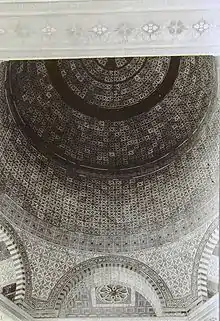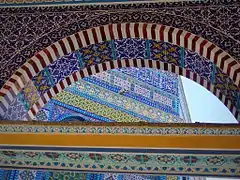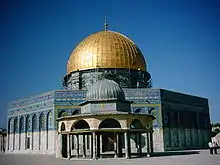Dome of the Chain
Dome of the Chain (Arabic: قبة السلسلة), Qubbat al-Silsilah; Hebrew: כיפת השלשלת) is a free-standing dome located adjacently east of the Dome of the Rock in the Old City of Jerusalem. It is one of many small buildings that can be found scattered around Haram ash-Sharif (The Temple Mount). Its exact historical use and significance are under scholarly debate, along with the date of its creation. The Dome of the Chain is one of the oldest surviving structures on the Temple Mount.[1]
-Temple_Mount-Dome_of_the_Chain_(south_exposure).jpg.webp)
It was built by the Umayyads, became a Christian chapel under the Crusaders, was restored as an Islamic prayer house by the Ayyubids, and has been renovated by the Mamluks, Ottomans and the Jordanian-based waqf.
Architecture
-Temple_Mount-Dome_of_the_Chain_(Mihrab).jpg.webp)
The building consists of a domed structure with two concentric open arcades, that is: with no lateral walls closing it in. The dome, resting on a hexagonal drum, is made of timber and is supported by six columns which together create the inner arcade. The second, outer row of eleven columns creates an eleven-sided outer arcade. The qibla wall contains the mihrab or prayer niche and is flanked by two smaller columns.[2] There are a total of seventeen columns in the structure, excluding the mihrab. It is known from historical sources that initially there used to be twenty columns, indicating a radical rebuilding phase, probably in the 13th century.[3] The Dome of the Chain has a diameter of 14 meters (46 ft), making it the third largest building on the Haram after the al-Aqsa Mosque and the Dome of the Rock.[4]
Some architectural elements used as part of the structure date to pre-Islamic times,[2] but it is widely accepted by both Arab and Western scholars that the Dome of the Chain was originally built in 691 by the Umayyad caliph Abd al-Malik.[5][4] The Umayyad design of the building has largely remained unaltered by later restorations.[2]
History and Significance

When the Crusaders invaded the Levant in 1099, they identified the dome as the spot where Saint James was martyred, and transformed the building into a chapel dedicated to him within the Templum Domini. In 1187, the building was returned to Muslim use after Saladin captured Jerusalem from the Crusaders. In 1199–1200, the ceiling and pavings were renewed by the ruling Ayyubids.[2] The Christians re-used the place in 1240–1244, before it reverted to Muslim use. The structure was renovated by the Mamluk sultan Baybars (r. 1260–1277). The latter's renovations likely involved the refacing of the mihrab with marble. In 1561, under the Ottoman sultan Suleiman the Magnificent, the tiles of the mihrab were glazed and later in 1760, more tile work was done.[2] The last major restoration undertaken at the Dome of the Chain was commissioned by the Islamic waqf of Jerusalem in 1975-76.[2]
Historical Use Theories
The exact historical use of the Dome of the Chain is still widely debated. The Dome of the Chain has been speculated to have a series of different purposes, which have not been confirmed. It is thought that the site was a place of holy judgment, a treasury, or a model for the construction of the Dome of the Rock.[6]
The Dome of the Chain has been theorized by Medieval Century art historians and scholars to be a site of holy judgment, based on Old Testament scripture. The dome was referenced by Ibn 'Abd Rabbihi in 913 CE as being the locational site of "the chain" that the "Children of Jerusalem" would hang and use a method of judgement. Another scholar, Nāsir-i Khosro, visited Jerusalem in 1047 CE, echoing Ibn 'Abd Rabbihi, claiming that on this location that the chain of David would have been hung and ungraspable by those who were wicked and unjust. 'Ali of Herat also depicted the dome as being the site in which David, the son of Solomon was able to administer justice. The use of names and phrases, such as "Son of David," "Solomon," and the "Children of Israel" imply a deep connection between Islamic traditions and the Jewish heritage.[7]
A second theory that has been created about the Dome of the Chain's historical usage is that it could have been a treasury, or bayt-al-māl. Some scholars, such as Muthīr al-Gharām and Mujīr al-Dīn speculate that the bulding could have been used as a traditional treasury, however the open structure of the build has created doubts amongst art historians on this interpretation.[8] The typical Umayyad treasury was often built with a closed structure, with one row of columns and a dome. The Dome of the Chain has a dome, like typical treasuries, but has an open structure and two rows of columns, which has pushed this theory to be abandoned by historians.
The Dome of the Chain has thirdly been speculated of being a small-scale model of the Dome of the Rock, built during its original construction. Scholars such as Mujīr al-Dīn questioned in 1496 CE as to if the Dome of the Chain could have been a rough draft of what the Dome of the Rock was meant to look like, but this has since been disproved. A model would not have been left up after construction, nor does the open structure of the Dome of the Chain mirror the facade of the Dome of the Rock.[9] Like the Dome of the Rock, the Dome of the Chain consists of two concentric polygons, with columns bound together by arcades and wooden beams. The Dome of the Rock is three times the size of the Dome of the Chain and the ground plan and height are relatively proportional. What does not seem to support this theory is the contrast between the perfect octagonal symmetry of both archways of the Dome of the Rock, and the mix of a hexagonal inner arcade and an (initially) fourteen-sided outer one for the Dome of the Chain. The lack of an outer wall is an additional issue. These elements deter medieval scholars from believing this to be the Dome of the Chain's purpose.
Religious significance
The Dome of the Chain owes its name to an ancient legend during King Solomon's rule. According to Mujir ad-Din,
Among the wonders of the Holy House is the chain, which Solomon, son of David, suspended between Heaven and Earth, to the east of the Rock, where the Dome of the Chain now stands. The chain had one characteristic. If two men approached it to solve a point of litigation, only the honest and upright man could take hold of it; the unjust man saw it move out of his reach.[3]
The building in Islamic tradition is the spot where Judgment Day will occur in the "end of days" and where a chain will stop the sinful and let the just pass through. Notably, the mihrab in the al-Aqsa Mosque is located exactly in the middle of the qibla wall of the Temple Mount on north-south axis with the Dome of the Chain.[4] [10]
This indicates that it located on the omphalos of Jerusalem, in which it is aligned with the Mosque al-Aqsa, particularly the qibla mihrab niche.[11] The omphalos can be defined as a religious artifact or object. In association with the Dome of the Rock, this omphalos would be the tomb where Adam was found, and where the first man was created.[12] This placement would have been indicative of the notion that the Umayyad Caliphs were direct descendents of the Children of Ishmael, in which power would have been passed from the "Children of Israel," to the "Children of Ishmael." The Umayyads wanted to portray themselves as the inheritors of "Davidic justice," in which they would be the ruler's of the Day of Judgement.The Dome of the Chain was also the location where the pledge of allegiance was taken by Caliphs Sulayman b. 'Abd al-Malik and 'Umar b. 'Abd al-'Aziz.[13] The pledge of allegiance oath would have secured them as being the rightful divine leaders of Davidic justice, emphasized by the religious significance of the location.
Gallery
 Dome of the Chain, interior detail
Dome of the Chain, interior detail Dome of the Chain with Dome of the Rock detail behind
Dome of the Chain with Dome of the Rock detail behind
References
- "Qubba al-Silsila". Archnet. Retrieved 7 December 2020.
- Pringle, Denys. (1993). The Churches of the Crusader Kingdom of Jerusalem: A Corpus, Vol. III Cambridge University Press, pp.182-184.
- Murphy-O'Connor, Jerome. (2008). The Holy Land: An Oxford Archaeological Guide from Earliest Times to 1700 Oxford University Press, p.97. ISBN 0-19-923666-6.
- Dome of the Chain Archived 6 October 2008 at the Wayback Machine Archnet Digital Library.
- Al-Aqsa Guide: 31. Dome of the Chain (Silsilah) Al Aqsa Friends 2007. Archived 6 October 2008 at the Wayback Machine
- ROSEN-AYALON, MYRIAM (1989). "THE EARLY ISLAMIC MONUMENTS OF AL-ḤARAM AL-SHARĪF: AN ICONOGRAPHIC STUDY". Qedem. 28: 26. ISSN 0333-5844.
- ROSEN-AYALON, MYRIAM (1989). "THE EARLY ISLAMIC MONUMENTS OF AL-ḤARAM AL-SHARĪF: AN ICONOGRAPHIC STUDY". Qedem. 28: 26. ISSN 0333-5844.
- ROSEN-AYALON, MYRIAM (1989). "THE EARLY ISLAMIC MONUMENTS OF AL-ḤARAM AL-SHARĪF: AN ICONOGRAPHIC STUDY". Qedem. 28: 27. ISSN 0333-5844.
- ROSEN-AYALON, MYRIAM (1989). "THE EARLY ISLAMIC MONUMENTS OF AL-ḤARAM AL-SHARĪF: AN ICONOGRAPHIC STUDY". Qedem. 28: 27. ISSN 0333-5844.
- Tillier, Mathieu (2018), "'Abd al-Malik, Muḥammad et le Jugement dernier: le dôme du Rocher comme expression d'une orthodoxie islamique", Les vivants et les morts dans les sociétés médiévales, Éditions de la Sorbonne, pp. 341–365, doi:10.4000/books.psorbonne.53878, ISBN 979-10-351-0092-6
- Mostafa, Heba (8 October 2017). "From the Dome of the Chain to Miḥrāb Dāʾūd: The Transformation of an Umayyad Commemorative Site at the Haram al-Sharif in Jerusalem". Muqarnas Online. 34 (1): 11. doi:10.1163/22118993_03401p002. ISSN 0732-2992.
- Grabar, Oleg (15 May 2017), "The Umayyad Dome of the Rock in Jerusalem", Early Islamic Art and Architecture, Routledge, p. 39, ISBN 978-1-315-25728-0, retrieved 8 November 2020
- Mostafa, Heba (8 October 2017). "From the Dome of the Chain to Miḥrāb Dāʾūd: The Transformation of an Umayyad Commemorative Site at the Haram al-Sharif in Jerusalem". Muqarnas Online. 34 (1): 11. doi:10.1163/22118993_03401p002. ISSN 0732-2992.
External links
- A virtual reality model of the interior and exterior can be explored on Sketchfab.
![]() Media related to Dome of the Chain at Wikimedia Commons
Media related to Dome of the Chain at Wikimedia Commons

